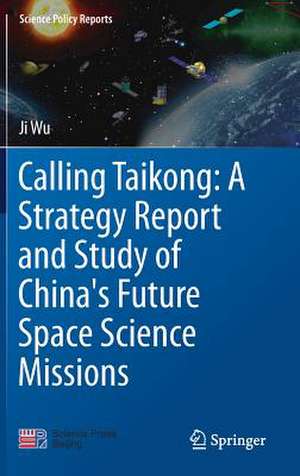Calling Taikong: A Strategy Report and Study of China's Future Space Science Missions: Science Policy Reports
Autor Ji Wuen Limba Engleză Hardback – 4 ian 2018
“Taikong” means “outer space” in Chinese, and space science is one of the most important areas China plans to develop in the near future. This book is authored by Ji Wu, a leader of China's space science program, together with National Space Science Center, Chinese Academy of Sciences, a leading institute responsible for planning and managing most of China’s space science missions. It also embodies the viewpoints shared by many space scientists and experts on future space science development. Through this book, general readers and researchers alike will gain essential insightsinto the current developments and future prospects of space science in China. Government decision-makers will also find the book a useful reference for strategies and planning in the field of space science.
| Toate formatele și edițiile | Preț | Express |
|---|---|---|
| Paperback (1) | 540.21 lei 38-45 zile | |
| Springer Nature Singapore – 9 dec 2018 | 540.21 lei 38-45 zile | |
| Hardback (1) | 635.15 lei 6-8 săpt. | |
| Springer Nature Singapore – 4 ian 2018 | 635.15 lei 6-8 săpt. |
Preț: 635.15 lei
Preț vechi: 747.23 lei
-15% Nou
Puncte Express: 953
Preț estimativ în valută:
121.55€ • 126.74$ • 101.02£
121.55€ • 126.74$ • 101.02£
Carte tipărită la comandă
Livrare economică 21 martie-04 aprilie
Preluare comenzi: 021 569.72.76
Specificații
ISBN-13: 9789811067365
ISBN-10: 9811067368
Pagini: 52
Ilustrații: IX, 52 p. 19 illus., 6 illus. in color.
Dimensiuni: 155 x 235 mm
Greutate: 0.27 kg
Ediția:1st ed. 2017
Editura: Springer Nature Singapore
Colecția Springer
Seria Science Policy Reports
Locul publicării:Singapore, Singapore
ISBN-10: 9811067368
Pagini: 52
Ilustrații: IX, 52 p. 19 illus., 6 illus. in color.
Dimensiuni: 155 x 235 mm
Greutate: 0.27 kg
Ediția:1st ed. 2017
Editura: Springer Nature Singapore
Colecția Springer
Seria Science Policy Reports
Locul publicării:Singapore, Singapore
Cuprins
Preface.- Overview.- Current status of space science in China.- Scientific Questions to be addressed.- Strategic Goals and Programs through 2030.- Supporting technologies.- Development beyond 2030.- Conclusion.- Acronyms.- References.
Recenzii
“This slim volume provides a helpful summary of the state of the overall Chinese space-science programme as it looked in 2016. … This volume will impress those unfamiliar with the programme and perhaps even make you jealous of the range of missions available. Whatever happens next will be exciting.” (Paul O’Brien, The Observatory, Vol. 138 (1267), December, 2018)
Notă biografică
Ji Wu is a professor and the Director General of National Space Science Center, Chinese Academy of Sciences. He also serves as the President of the Chinese Society of Space Research. WU Ji got his Ph.D. from Technical University of Denmark in 1993, and has been engaging in the research on antenna design and measurement, microwave remote sensing technology, space science and exploration. He has a batch of independent intellectual rights in passive microwave imagers using innovated interfereometric imaging technology, feed exciting coefficients optimization of contoured beam antenna on geostationary communication satellites, spherical scan near-field antenna measurement theory etc.
Previously, he was the chief designer and project manager of the payload and application system of Geo-space Double Star Program, project manager of the scientific payload of Chinese Lunar Exploration Program Chang’E-1 and Chang’E-2 satellite, chief scientist of China-Russia cooperation Yinghuo-1 scientificsatellite. Currently, he is the project manager of payload subsystem of Chang’E-3 satellite and Strategic Pioneer Program on Space Science. In 2010, he received the Laurels Outstanding Team Achievement Award from International Academy of Astronautics (IAA).
Textul de pe ultima copertă
This book describes the status quo of space science in China, details the scientific questions to be addressed by the Chinese space science community in 2016-2030, and proposes key strategic goals, space science programs and missions, the roadmap and implementation approaches. Further, it explores the supporting technologies needed and provides an outlook of space science beyond the year 2030.
“Taikong” means “outer space” in Chinese, and space science is one of the most important areas China plans to develop in the near future. This book is authored by Ji Wu, a leader of China's space science program, together with National Space Science Center, Chinese Academy of Sciences, a leading institute responsible for planning and managing most of China’s space science missions. It also embodies the viewpoints shared by many space scientists and experts on future space science development. Through this book, general readers and researchers alike will gain essential insightsinto the current developments and future prospects of space science in China. Government decision-makers will also find the book a useful reference for strategies and planning in the field of space science.
“Taikong” means “outer space” in Chinese, and space science is one of the most important areas China plans to develop in the near future. This book is authored by Ji Wu, a leader of China's space science program, together with National Space Science Center, Chinese Academy of Sciences, a leading institute responsible for planning and managing most of China’s space science missions. It also embodies the viewpoints shared by many space scientists and experts on future space science development. Through this book, general readers and researchers alike will gain essential insightsinto the current developments and future prospects of space science in China. Government decision-makers will also find the book a useful reference for strategies and planning in the field of space science.
Caracteristici
Provides a cutting-edge overview of space science research in China Illustrates a dozen space science probes and includes detailed description of the missions Presents extensive proposals for the further development of space science in China Includes supplementary material: sn.pub/extras










